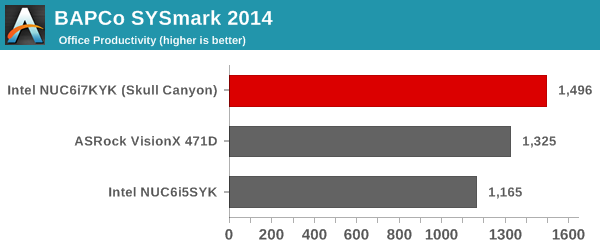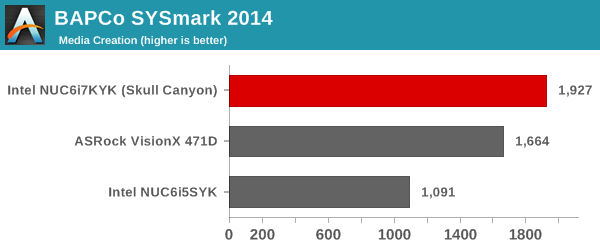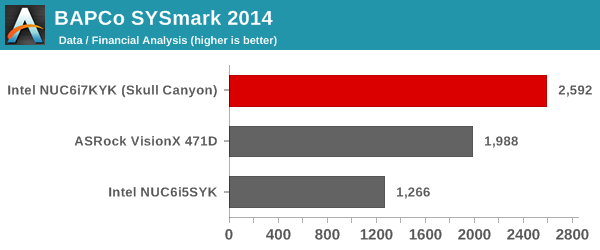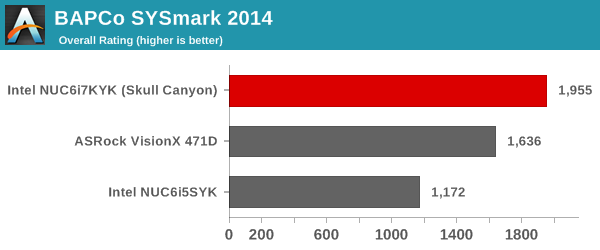The Intel Skull Canyon NUC6i7KYK mini-PC Review
by Ganesh T S on May 23, 2016 8:00 AM ESTPerformance Metrics - I
The Intel NUC6i7KYK (Skull Canyon) was evaluated using our standard test suite for low power desktops / industrial PCs. Not all benchmarks were processed on all the machines due to updates in our testing procedures. Therefore, the list of PCs in each graph might not be the same. In the first section, we will be looking at SYSmark 2014, as well as some of the Futuremark benchmarks.
BAPCo SYSmark 2014
BAPCo's SYSmark 2014 is an application-based benchmark that uses real-world applications to replay usage patterns of business users in the areas of office productivity, media creation and data/financial analysis. Scores are meant to be compared against a reference desktop (HP ProDesk 600 G1 with a Core i3-4130, 4GB RAM and a 500GB hard drive) that scores 1000 in each of the scenarios. A score of, say, 2000, would imply that the system under test is twice as fast as the reference system.




We started using SYSmark 2014 quite recently, which is the main reason for the absence of many of the comparison systems in the above graphs. In any case, the most interesting of the compared lot when it comes to CPU-intensive benchmarks like SYSmark 2014 is the ASRock VisionX 471D, equipped with a Core i7-4712MQ processor. We can see that the Core i7-6770HQ-based Skull Canyon NUC6i7KYK is miles ahead of the other two systems when it comes to office / business workloads. Readers interested in comparing the SYSmark 2014 scores for systems based on other CPUs can peruse the Bench results here.
Futuremark PCMark 8
PCMark 8 provides various usage scenarios (home, creative and work) and offers ways to benchmark both baseline (CPU-only) as well as OpenCL accelerated (CPU + GPU) performance. We benchmarked select PCs for the OpenCL accelerated performance in all three usage scenarios. These scores are heavily influenced by the CPU in the system. As expected, the Core i7-6770HQ enables the NUC6i7KYK to easily come out on top in the charts.



Miscellaneous Futuremark Benchmarks

The graphics benchmarks present a different story, though. In these, the NUC6i7KYK does perform well enough to come in the top half. However, in scenarios which are not CPU-bound, the systems equipped with discrete GPUs easily turn out to be better than Skull Canyon.




3D Rendering - CINEBENCH R15
CINEBENCH R15 is a standard benchmark for 3D rendering. It provides three benchmark modes - OpenGL, single threaded and multi-threaded. Evaluation of select PCs in all three modes provided us the following results.



In the single-threaded case, the Core i7-4770R (a 65W TDP CPU which can turbo up to 3.9 GHz) performs slightly better than the Core i7-6770HQ. However, the latter wins out in the multi-threaded cases. In the OpenGL case, the GIGABYTE system with the discrete GPU wins out, showing that a combination of CPU power as well as GPU is needed to perform well in this benchmark.










133 Comments
View All Comments
Kimo19 - Monday, May 23, 2016 - link
thanks a lot for the review. I am thinking to get this machine for photos editing (lightroom) and mobile development. would it be a good choice ? I was thinking the processor/ram/ssd are good enough to provide great performance for the next 2/3 years and the iris pro can be a good gpu to support monitor with high resolutionTheinsanegamerN - Monday, May 23, 2016 - link
For the price you could get something much more powerful, or something along the same power with better GPU support for a cheaper price then this NUC.fanofanand - Monday, May 23, 2016 - link
Keep in mind that you are bringing your own RAM and SSD, the kit does not include those items for the consumer. As for the iGPU providing support for high resolution, I think that will depend entirely on your workload.alpha64 - Monday, May 23, 2016 - link
Ganesh, Did you get confirmation directly from Intel that the PCI-E is limited on this system because it runs through the H170? From my research on ARK and other places, it appears that the H170 acts as a PCI Express passthrough, with a PCI express 3.0 x16 connection to the CPU, and the ability to split the configuration off to smaller widths and more ports coming off the H170. It would seem the DMI3 connection is for other (non-PCI express) peripherals. Granted, from the block diagram, it is not apparent that the H170 connects to the CPU's PCI-E x16 connection, but my guess is that it does.I would just like clarification, as this is a pretty big deal.
ganeshts - Monday, May 23, 2016 - link
I have confirmation from the technical marketing manager for NUC products at Intel that the communication link between the H170 and the CPU is only effectively PCIe 3.0 x4 for bandwidth purposes. It is definitely not a PCIe 3.0 x16.H170 itself can act as a PCIe switch, but, for anything that talks to the CPU, it has to go through the DMI 3.0 lanes.
alpha64 - Monday, May 23, 2016 - link
Thanks for the clarification!extide - Monday, May 23, 2016 - link
The 16 CPU lanes are entirely un-used in this device. The PCH (H170 in this case) is NEVER connected by a PCIe x16 link -- it is always connected via DMI 3.0 in the H, Q, B and Z platforms. DMI 3.0 has the same B/W as PCIe 3.0 x4. All of the stuff hanging off the H170 shares that same DMI 3.0 link.alpha64 - Monday, May 23, 2016 - link
Great to know, can you tell me what "Processor PCI Express Port" under "I/O Specifications" details are for on the Intel's ARK for the H170 part? I thought they were for connecting to the PCI Express on the CPU, but would be happy to learn if I am incorrect.Valantar - Monday, May 23, 2016 - link
I'm disappointed in the lack of teardown pictures. I was at the very least expecting a look at the cpu side of the board. Is that too much to ask?Also, considering the massive power throttling seen in your testing, and the torture test nature of the testing, I'd love it if you could monitor clocks and temps during gaming too - I'd be interested in seeing what kind of cpu clocks this can maintain in a low-threaded gaming workload.
allanmac - Monday, May 23, 2016 - link
Please run SGEMM on the HD 580 ... ASAP! :)https://software.intel.com/en-us/articles/sgemm-fo...